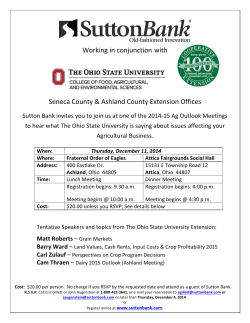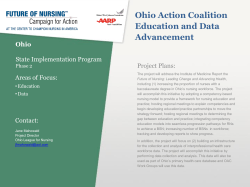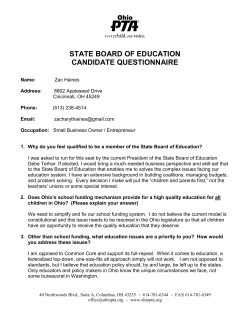
- Midwest Veterinary Conference
Ohio State Board of Pharmacy Compliance in Veterinary Practice 2015 Midwest Veterinary Conference Greater Columbus Convention Center, Columbus, Ohio February 19-22, 2015 Steven Schierholt, ESQ Executive Director Ohio State Board of Pharmacy 614-466-4143 Sheri Zapadka, PharmD, R.Ph. Compliance Specialist Ohio State Board of Pharmacy Sheri.Zapadka@bop.ohio.gov 614-433-4143 Topics Definitions Licensure Security Recordkeeping Drug Destruction Theft or loss Personally Furnished Medications Labeling Prescription Requirements Euthanasia Compounding Pick-Up Station © Ohio State Board of Pharmacy Definitions Ohio Revised Code 4729.01 (F) Dangerous Drug All prescription drugs are Dangerous Drugs Caution: Federal Law Prohibits Dispensing Without a Prescription. Caution: Federal Law restricts this drug to the use by or on the order of a licensed veterinarian. Rx Only. Any drug intended for administration by injection into the human body other than through a natural orifice of the human body. Animal vaccines are not dangerous drugs, they are regulated by the U.S. Department of Agriculture, not the FDA. Statements such as : Sold only to Veterinarians, Exclusively for Veterinary use do not define products as Dangerous Drugs. © Ohio State Board of Pharmacy Definitions Ohio Revised Code 4729.01 (J) Sale and Sell: Include delivery, transfer, barter, exchange, or gift or offer therefor, and each such transaction made by any person, whether as principal proprietor, agent or employee. (K) Wholesale Sale: Means any sale in which the purpose of the purchaser is to resell the article purchased or received by the purchaser. © Ohio State Board of Pharmacy Licensure Terminal Distributor of Dangerous Drugs Licenses (TDDDs) allow business entities to purchase and possess dangerous drugs at a specific address for distribution to patients. Distribution includes on-site administration and providing medications to patients for use at home. Registered Wholesalers may not sell to anyone other than: Individual health care professionals authorized to prescribe dangerous drugs in the course of practice Terminal Distributors of Dangerous Drugs Wholesale Distributors of Dangerous Drugs Manufacturers © Ohio State Board of Pharmacy Licensure Businesses that DO NOT require a TDDD License A business practice that is a corporation, limited liability company or professional association if the business has a SOLE SHAREHOLDER who is a licensed health professional authorized to prescribe drugs. Also defined as: a business practice with a single prescriber (DVM), who is the sole shareholder, member or owner of the practice, including Sole Proprietors. © Ohio State Board of Pharmacy Licensure Terminal Distributor Licenses for Compounded Drugs and On-Site Compounding: ORC 4729.541 Effective April 1, 2015 Business entities who possess, have custody of control of, and distribute dangerous drugs that are compounded or used for the purpose of compounding must hold a license as a Terminal Distributor of Dangerous Drugs. www.pharmacy.ohio.gov/TDDDCompounding © Ohio State Board of Pharmacy Licensure Who: Business entities that are corporations, limited liability companies, or professional associations, if the entity has a sole shareholder who is a licensed health professional authorized to prescribe drugs. Limited liability companies, partnerships, or limited liability partnerships or professional associations, if to be a shareholder, member or partner, an individual is required to be licensed, or certified to perform the professional service provided by the entity, and each such individual is a licensed health professional authorized to prescribe drugs. © Ohio State Board of Pharmacy Licensure Exceptions: A prescriber who practices as a sole proprietor is exempt form licensure as a Terminal Distributor of Dangerous Drugs. © Ohio State Board of Pharmacy Licensure DEA License DEA registration is required for all practitioners who possess, distribute, or prescribe controlled substances. One registration is required for each address where controlled substances are located. Multiple practitioner offices require separate registration if controlled substances are stored at each location. Offices located in different states must be individually registered with the DEA. Individual practitioners within the same practice must maintain a DEA registration in order to write prescriptions to be dispensed outside the practice. 21 CFR 1301.22 © Ohio State Board of Pharmacy Drug Security Ohio Administrative Code 4729-9-11, 4729-9-05 All Dangerous Drugs must be secured and provide adequate safeguards to prevent diversion. Dangerous Drugs must be secured in a manner that detects and deters unauthorized access. Responsible person must monitor purchases, usage, and disposition. © Ohio State Board of Pharmacy Recordkeeping Ohio Administrative Code 4729-9-22, 4729-9-14, 4729-5-01 A record of all dangerous drugs received, administered, dispensed, distributed, sold, destroyed or used, must be kept on file for 3 years at the place where dangerous drugs are stored. Upon request, records must be provided to the Ohio State Board of Pharmacy within 3 working days. Records of prescribing, administering, dispensing and destroying must be documented with the positive identification of the responsible individual. © Ohio State Board of Pharmacy Recordkeeping Ohio Administrative Code 4729-5-01 Positive Identification A method of identifying an individual who prescribes, administers, or dispenses a dangerous drug. Method must also include a secure means of identification: Manual signature on hard copy record Magnetic Card Readers (with password/private personal identifier) Bar Code Readers (with password/private personal identifier) Biometrics Proximity Badge Pharmacy Board approved randomly generated questions Manually signed transaction printout © Ohio State Board of Pharmacy Recordkeeping Ohio Administrative Code 4729-9-14 (Controlled Substances) A physical inventory of Controlled Substances must be taken annually. Date of Inventory Name, strength and finished form of substance Number of units or volume of each finished form in each commercial container Total quantity Schedule I or II substances require an exact count. Schedule III, IV or V may make an estimated count unless the container holds more than 1000 tables/capsules. Zero inventory is required if no Controlled Substances are on hand. © Ohio State Board of Pharmacy Drug Destruction Ohio Administrative Code 4729-9-06, 4729-9-22 Ohio licensed sites require written permission from the Board of Pharmacy to destroy controlled substances. Non-licensed sites must follow DEA requirements. Use DEA Form 41 to generate a record of drugs destroyed. Ohio licensed sites must upload DEA 41 to the OSBP website within 30 days of the completion of destruction. (www.pharmacy.ohio.gov) Destruction record must include: Drug name Drug strength Drug dosage form Quantity destroyed Date destroyed Method of destruction Positive identification of the person destroying Positive identification of the witness to destruction for controlled substances © Ohio State Board of Pharmacy Drug Destruction Ohio Administrative Code 4729-9-17 Adulterated drugs may not be stored longer than 1 year from the date of adulteration/expiration. Methods of disposal shall prevent the possession of the drugs by unauthorized persons. Per DEA, “Non-retrievable” means the condition or state to which a controlled substance shall be rendered following a process that permanently alters that controlled substances physical or chemical condition or state through irreversible means, and thereby renders the controlled substance unavailable and unusable. A controlled substance is considered non-retrievable when it cannot be transformed into a physical or chemical condition or state as a controlled substance or a controlled substance analog. © Ohio State Board of Pharmacy Theft or Loss Ohio Administrative Code 4729-9-15 Ohio Revised Code 2921.22 REQUIRED to report: Suspected theft Confirmed (significant) loss Report upon discovery immediately by telephone to the Ohio State Board of Pharmacy and local law enforcement Complete DEA form 106: Electronically file with the DEA Email to the Board within 30 days at DEA106reporting@bop.ohio.gov © Ohio State Board of Pharmacy Personally Furnish Ohio Revised Code 4729.29, 4729.291 A licensed health professional authorized to prescribe may personally furnish patients with dangerous drugs in the scope of their professional practice. Drugs must be labeled and packaged in accordance with state and federal drug laws. Records must be kept in accordance with state and federal drug laws. Positive Identification of the veterinarian furnishing the drug must be recorded. No refills are permitted. Medications may only be furnished when the veterinarian is on-site. Anyone can prepare and pass out medications provided the veterinarian checks the preparation prior to release. © Ohio State Board of Pharmacy Labeling Ohio Administrative Code 4729-5-17 The label of drugs personally furnished to patients must include: Name and address of veterinarian Name of client and identification of the animal Drug name and strength Directions for use Date dispensed Any cautionary statements Child Resistant Closures? © Ohio State Board of Pharmacy Manner of Issuance of a Prescription Ohio Administrative Code 4729-5-30 Prescriptions must be issued for a legitimate medical purpose by a practitioner acting in the usual course of their professional practice. Requirements: Prescriber name, title, address and phone number Date issued Name and address of patient (ID of animal or herd/flock) Drug name and strength Quantity (numerically and alphabetically if controlled) Directions for use – Be specific! Number of refills DEA # if controlled substance Manual signature of prescriber © Ohio State Board of Pharmacy Euthanasia of Animals Ohio Administrative Code 4729.531, 4729.532 Limited License to Animal Shelters for Euthanasia Animal shelters may apply for a Limited Terminal Distributor of Dangerous Drugs License for the purpose of purchasing, possessing, and administering combination drugs that contain pentobarbital and at least one other non-controlled substance, in a manufactured dosage form whose only indication is for euthanizing animals. © Ohio State Board of Pharmacy Euthanasia of Animals License holders are not permitted to distribute these drugs to any person. Licensure requires that an agent or employee of an animal shelter, other than a registered veterinary technician, has successfully completed a euthanasia technician certification course. Euthanasia methods include: Intravenous Injection Intraperitoneal Injection Intracardial Injection (only on sedated/unconscious animals) Solution or Powder added to food © Ohio State Board of Pharmacy Euthanasia of Animals Registered veterinary technicians or certified euthanasia technicians may perform euthanasia by lethal injection. Euthanasia technician certification courses must be approved by the state Veterinary Medical Licensing Board. Animal Shelter agents/employees may not perform euthanasia by lethal injection unless the facility is licensed with the State Board of Pharmacy. © Ohio State Board of Pharmacy Compounding Definition: The preparation , mixing, assembling, packaging, and labeling of one or more drugs pursuant to a prescription issued by a licensed health professional authorized to prescribe drugs, or pursuant to a request made by a licensed health professional for the purpose of direct administration to patients in the course of professional practice. © Ohio State Board of Pharmacy Compounding Who may compound? A pharmacist- pursuant to a valid prescription A veterinarian- to provide to his/her own patients Veterinary practices properly licensed by the Ohio State Board of Pharmacy What Can I compound? Non-commercially available products. Unique dosages/dosage forms specific to the animal population. Compounding from approved animal or human drugs under the conditions set forth in 21 CFR 530.13. © Ohio State Board of Pharmacy Compounding Compounding should be limited to: 1. Individual patients which no other method or route of drug delivery is practical. 2. Drugs for which safety, efficacy and stability have been demonstrated in the specific compounded form for the specific animal. 3. Disease conditions for which a quantifiable response to therapy or drug concentration can be monitored. © Ohio State Board of Pharmacy Compounding Compounding Records: Master Formula – inspect and approve the compounding process Compounding Worksheet Patient name Drug name/strength/dose Quantity added to each container Disposition of unused drugs Manufacturers name (if generic) lot #, expiration date Date of compounding Beyond Use date of compounded product Documentation of compounder Positive identification of the Veterinarian performing the final check of the finished product © Ohio State Board of Pharmacy Compounding Compounding does not include mixing, reconstituting, or other such acts performed in accordance with directions contained in approved labeling provided by a products manufacturer Compounded products must be assigned a BeyondUse date in accordance with USP 795/797, drug product testing, or published peer reviewed literature For more information see: CPG Sec. 608.400 – Compounding of Drugs for Use in Animals (FDA) © Ohio State Board of Pharmacy Compounding Pharmacies Must be licensed by the Ohio State Board of Pharmacy May compound patient specific drugs pursuant to a valid prescription. Must provide prescriptions directly to the patient/caregiver Veterinary Compounding training courses are available but not required. © Ohio State Board of Pharmacy Prescription Pick-Up Station Ohio Administrative Code 4729-5-10 A Pick-Up Station permits an entity to receive patient-specific prescription medications on behalf of the end user/patient. In order to be a pick-up station, a request must be submitted electronically to the Pharmacy Board. www.pharmacy.ohio.gov Facilities receiving prescription medication on behalf of a patient who does not live at the facility must become a PickUp station. www.pharmacy.ohio.gov/pickup © Ohio State Board of Pharmacy Prescription Pick-Up Station Requirements of a Pick-Up Station: Site must be appropriately licensed. Delivery of the prescription medication directly to the patient would result in: A danger to public health or safety. A danger to the patient without increased involvement from the health care professional. The receipt, storage, control, and distribution of prescriptions or drugs are in the full and actual charge of a health care professional. Appropriate recordkeeping systems are in place to account for the receipt, delivery and return of all prescription medications. © Ohio State Board of Pharmacy Questions? © Ohio State Board of Pharmacy
© Copyright 2025









